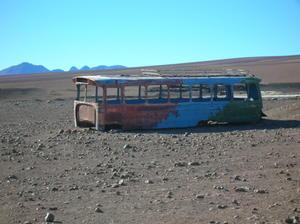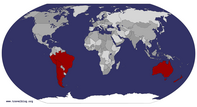Advertisement
Published: July 17th 2006

 Welcome to Bolivia
Welcome to Bolivia
This was our first image on crossing into Bolivia. This bus had had an accident with a minefield.So we have finished our luxurious stage of our South American journey (Chile and Argentina) and now are heading into Bolivia. The plan - a three day trip across the volcanic landscape and largest salt flat in the world in South West Bolivia. After leaving the paved road behind in Chile we drove in 4 X 4 jeeps up to 4600 m to the Bolivian immigration control. After a dubious breakfast of bread, cheese and jam we continued with Juan our driver a couple from Belgium, a girl from Switzerland and another from Canada.
Within 20 mins we had reached Laguna Blanca the white lake. In summer there would normally be flamingos here but in the middle of winter the lake was covered in a thick sheet of ice. On further towards Laguna Verde (the green lake) we got fantastic panoramic views of the lakes and volcanoes in this area. After more rapid altitude gain we arrived at 5000m to one of the most active thermal reserves in South America. Huge craters of bubbling mud and venting steam were cautiously walked around breathlessly (a massive height gain in 3 hours from 2500m left you breathless).
Anne wanted to go

 Laguna Verde
Laguna Verde
Meaning the green lake - some chemical in the water turns it green. Behind a big volcano 5900m.swimming in a thermal pool which we just happened to be passing at the time - James once again was sensible enough to realise that at 4800m it was going to be cold when you got out. She persisted and went swimming in a very nice location. She claims that it was not cold when getting out.
A short 30 min drive brought us to the hotel which we were staying in for the night and also where we were having lunch. Not bad food considering the location! The hotel was little more than a mud hut. No running water, very little in the way of insulation and shockingly bad mattresses. At 4600m it was going to get very cold in the night.
However whilst the sun still shone we wandered over to the Red Lake where we saw our first flamingos. Actually we saw hundreds of the things, along with llamas and some birds which looked like black headed gulls. The flamingos we very exciting but could only get close up pictures of them on the video camera. Here we also listened to the end of the world cup in which Italy thankfully won (although it was

 Please do not fall in Anne
Please do not fall in Anne
There is not much chance of help around here!a shockingly bad signal).
Back to the hotel (hotel in the looses possible term) the room air temperature was already 6C. Dinner of spaghetti bolognese was followed by bed at 7.30 as it was too cold for idle chat. Thankfully due to the invention of goose down sleeping bags Anne and I were warm despite the air temperature dropping below 0C. Comfortable however, James was not; on a mattress which sank to the floor in the middle.
The morning dawned blue skies and more rough dirt roads to drive along. Our aim was to reach the Salt Plain of Uyuni to a hotel made entirely of salt before nightfall. Juan our driver insisted on taking the roughest route, also at a speed suitable only for paved roads. We stopped at an odd rock formation in the middle of no-where for a few photos, followed by more rapid driving to our lunch stop by more flamingo filled lakes. These we were able to get closer to but still not close enough. James who was desperate to get a good photo was forced to concede after nearly falling through a thin mud crust into the lake.
The afternoon was

 The red lake
The red lake
The little pink dots in the bottom right corner are Flamingos - honestly.taken up by driving solidly including the worse bit of road which we would travel along. Just to say that you wouldn't bring your new Toyota along it is enough. Virtually only passable to very high clearance 4x4 - thankfully ours did and even Juan drove slowly and seemingly cautiously. After several more hours of driving we arrived at the salt hotel - it was a s**t hole. Fortunately it was full and we had to drive about 20 mins further to another salt hotel which was much nicer - even had table cloths and hot showers. Everything was made from salt including the tables and mattresses. Only the showers weren´t - for obvious reasons!!
Chicken and chips and a get to know you night followed helped with a few bottles of wine with the Belgium's and a couple from Switzerland. Also another night with James defending the NHS - they had better offer him a job when he gets back.
Anne and I got up early and walked down to the salt flat to watch sunrise. It was further than we had thought but we eventually got there. Prior to leaving for South America we had pretty

 Flamingos
Flamingos
Are they not cute!!much only one instruction from back home. This was that we weren't to wander onto the salt flats by ourselves. Here we were at 7am doing exactly this - however as we were only 30 metres onto it we didn't feel that it counted.
Leaving in the jeep we drove onto the salt flat - 12000 km square and fills with water in the wet season. Juan cranked up the speed on the near perfect flat surface. The salt is about 8 metres deep and in places mined. The blinding white surface is such an amazing contrast to the blue sky. The plain is interspersed with the occasional island. We stopped at one of these which just happened to be covered by hundreds of cactus. These grow at around 1cm a year some are supposed to be 1200 years old. No one knows how the cactus got here but James thinks that it was birds which dropped the seeds - mystery solved.
Lunch was served on salt tables which included some meat. At first we weren't sure what the hell it was but were worried it might be llama. Later found out that it was beef - didn't

 Toilet block in first hotel
Toilet block in first hotel
Manual flush from water barrel - had to break the ice in the morning.taste like any beef I have ever had though. Further driving across the enormous salt plain - had a quick visit to a salt mine and then finally reached the other side and drove into Uyuni via a train cemetery. We had planned on staying a few days in Uyuni but with its 12000 population and absolutely nothing to do here we rapidly decided only to spend one night in a freezing cold hotel.
An early start to get to the bus station for our transport to Potosi a mining town and the highest town of its size (pop 110000) in the world. This has got to be one of the most chaotic bus stations in the world. Kids as young as 6 were used to throw heavy rucksacks onto the roof of the bus. A guy who was our driver only had one leg and there were babies sleeping on the dash board whilst he drove. The road was dirt all the way with some not so insignificant drops on either side of the bus. After around four hours the bus stopped for lunch and pee break. Little did we expect that we would find no toilet and

 Anne by big random rock in desert
Anne by big random rock in desert
They can´t work out how this rock got here?that everyone just pees in the middle of the street!
Around 3 pm we arrived in Potosi. A huge hill behind the town is reputedly made mainly of silver. The incas and pachamama people saw the hill as sacred and therefore didn't mine it. Unfortunately when the Spanish arrived they put the locals and black slaves to work in the mine and hundreds of thousands of people died (in particular many of the black slaves died from poor oxygenation due to sickle cell anaemia). Now it is still worked but on much smaller scale.
After the previous night in a freezing hotel (which incidentally cost only 3 pounds for a double room) we decided it was time for some upmarket luxury. We checked ourselves into a 4* hotel called the Libertador. Was very nice as well (cost 15 pounds a night)
That night we went for a meal in a cheap restaurant recommended by the Footprint Guide. Unfortunately it was to be James' last meal for a few days. James opted for the trout which subsequently put him in bed for the next 24 hours with gastroenteritis. James apparently isn't as indestructible as he thought!!
The

 Flamingos
Flamingos
This is as close as you are going to get without a telescopic lens. Even so James got very muddy taking this photo and the water stank. So be thankful.following day James was well enough to visit the Casa de Moneda (the mint). This is supposed to be the best museum in Bolivia. It was full of artefacts from when it used to be a working Mint, with great lumps of silver and old coins dating back to the the mid 1500's. Fortunately we were able to get into an English speaking group. Interestingly there was also a French group but these required a security guard with them (presumably because the Mint thought that they might steal something - like they keep stealing our food).
The following morning - Anne with a migraine (she just fights through these things) we got a very old minibus up to Cerro Rico the enormous silver mine. First a trip to the market to buy plastic explosive and detonators (cost 70 pence) for presents for the miners. A demonstration by the guide into explosives was rather impressive - we were well away. With yellow overalls, lamps and helmets we stooped low into the mines. It is all hand worked, very dusty, cramped and noisy. You were also very conscious that the roof might fall in especially when they start blasting whilst you

 Entertainment in the Salt Hotel
Entertainment in the Salt Hotel
Cost us 1 Boliviano extra about 7 pence.are in the mines. Apparently 50 miners every year die out of 10,000. They work in medieval conditions.
Finally we got the bus to La Paz - an 8 hour reasonably comfortable journey. Unfortunately our first two hotels were full but we settled for a slightly cheaper one which has excellent decor.
We are now going to spend a few days in La Paz and James has his eye on a few 6000 metre mountains he would like to climb.
Advertisement
Tot: 0.097s; Tpl: 0.012s; cc: 17; qc: 87; dbt: 0.0555s; 1; m:domysql w:travelblog (10.17.0.13); sld: 1;
; mem: 1.3mb




















Georgie
non-member comment
blog vandalism
I'm quite shocked that the girls haven't realised that they can comment on your blog and hence create all sorts of havoc.......I will try and rectify this now.....